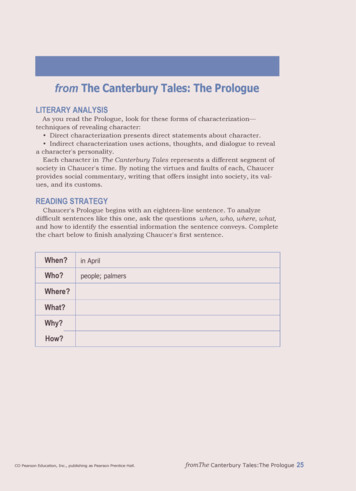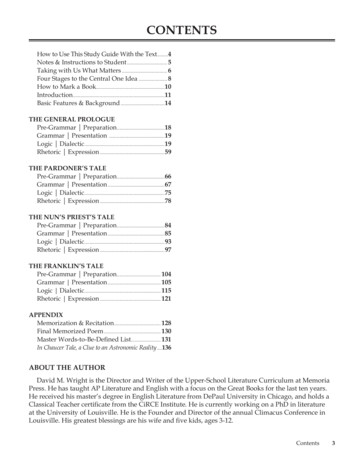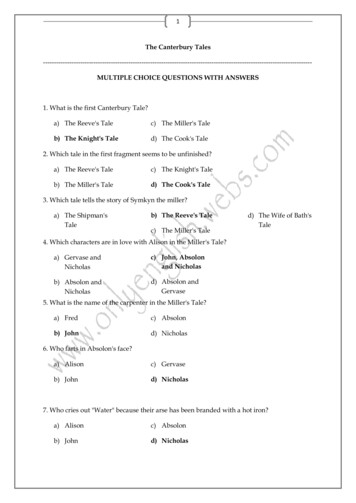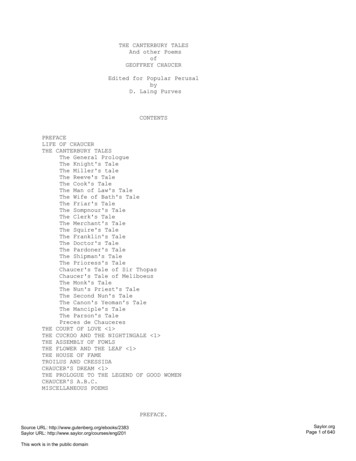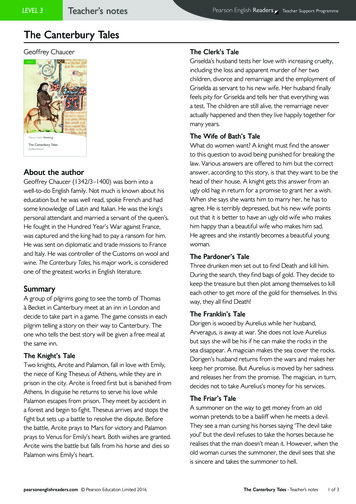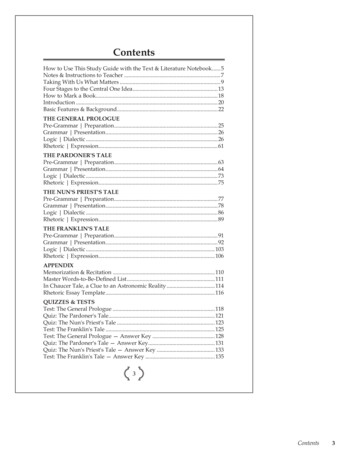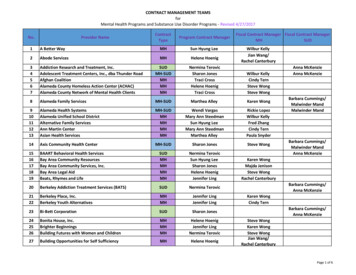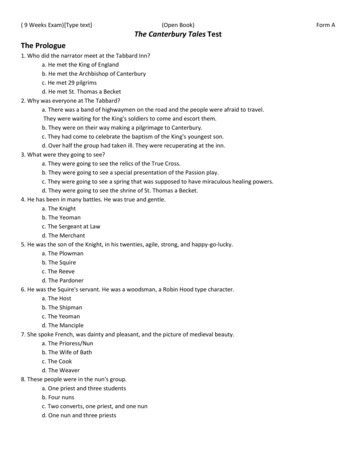
Transcription
THE CANTERBURY TALESAnd other PoemsofGEOFFREY CHAUCEREdited for Popular PerusalbyD. Laing PurvesCONTENTSPREFACELIFE OF CHAUCERTHE CANTERBURY TALESThe General PrologueThe Knight's TaleThe Miller's taleThe Reeve's TaleThe Cook's TaleThe Man of Law's TaleThe Wife of Bath's TaleThe Friar's TaleThe Sompnour's TaleThe Clerk's TaleThe Merchant's TaleThe Squire's TaleThe Franklin's TaleThe Doctor's TaleThe Pardoner's TaleThe Shipman's TaleThe Prioress's TaleChaucer's Tale of Sir ThopasChaucer's Tale of MeliboeusThe Monk's TaleThe Nun's Priest's TaleThe Second Nun's Tale
The Canon's Yeoman's TaleThe Manciple's TaleThe Parson's TalePreces de ChauceresTHE COURT OF LOVE 1 THE CUCKOO AND THE NIGHTINGALE 1 THE ASSEMBLY OF FOWLSTHE FLOWER AND THE LEAF 1 THE HOUSE OF FAMETROILUS AND CRESSIDACHAUCER'S DREAM 1 THE PROLOGUE TO THE LEGEND OF GOOD WOMENCHAUCER'S A.B.C.MISCELLANEOUS POEMSPREFACE.THE object of this volume is to place before the general reader our two early poeticmasterpieces — The Canterbury Tales and The Faerie Queen; to do so in a way thatwill render their "popular perusal" easy in a time of little leisure and unboundedtemptations to intellectual languor; and, on the same conditions, to present a liberaland fairly representative selection from the less important and familiar poems ofChaucer and Spenser. There is, it may be said at the outset, peculiar advantage andpropriety in placing the two poets side by side in the manner now attempted for thefirst time. Although two centuries divide them, yet Spenser is the direct and really theimmediate successor to the poetical inheritance of Chaucer. Those two hundred years,eventful as they were, produced no poet at all worthy to take up the mantle that fellfrom Chaucer's shoulders; and Spenser does not need his affected archaisms, nor hisfrequent and reverent appeals to "Dan Geffrey," to vindicate for himself a place veryclose to his great predecessor in the literary history of England. If Chaucer is the"Well of English undefiled," Spenser is the broad and stately river that yet holds thetenure of its very life from the fountain far away in other and ruder scenes.The Canterbury Tales, so far as they are in verse, have been printed without anyabridgement or designed change in the sense. But the two Tales in prose — Chaucer'sTale of Meliboeus, and the Parson's long Sermon on Penitence — have beencontracted, so as to exclude thirty pages of unattractive prose, and to admit the sameamount of interesting and characteristic poetry. The gaps thus made in the proseTales, however, are supplied by careful outlines of the omitted matter, so that thereader need be at no loss to comprehend the whole scope and sequence of the original.
With The Faerie Queen a bolder course has been pursued. The great obstacle to thepopularity of Spencer's splendid work has lain less in its language than in its length. Ifwe add together the three great poems of antiquity — the twenty-four books of theIliad, the twenty-four books of the Odyssey, and the twelve books of the Aeneid —we get at the dimensions of only one-half of The Faerie Queen. The six books, and thefragment of a seventh, which alone exist of the author's contemplated twelve, numberabout 35,000 verses; the sixty books of Homer and Virgil number no more than37,000. The mere bulk of the poem, then, has opposed a formidable barrier to itspopularity; to say nothing of the distracting effect produced by the numberlessepisodes, the tedious narrations, and the constant repetitions, which have largelyswelled that bulk. In this volume the poem is compressed into two-thirds of itsoriginal space, through the expedient of representing the less interesting and moremechanical passages by a condensed prose outline, in which it has been sought as faras possible to preserve the very words of the poet. While deprecating a too criticaljudgement on the bare and constrained precis standing in such trying juxtaposition, itis hoped that the labour bestowed in saving the reader the trouble of wading throughmuch that is not essential for the enjoyment of Spencer's marvellous allegory, will notbe unappreciated.As regards the manner in which the text of the two great works, especially of TheCanterbury Tales, is presented, the Editor is aware that some whose judgement isweighty will differ from him. This volume has been prepared "for popular perusal;"and its very raison d'etre would have failed, if the ancient orthography had beenretained. It has often been affirmed by editors of Chaucer in the old forms of thelanguage, that a little trouble at first would render the antiquated spelling and obsoleteinflections a continual source, not of difficulty, but of actual delight, for the readercoming to the study of Chaucer without any preliminary acquaintance with theEnglish of his day — or of his copyists' days. Despite this complacent assurance, theobvious fact is, that Chaucer in the old forms has not become popular, in the truesense of the word; he is not "understanded of the vulgar." In this volume, therefore,the text of Chaucer has been presented in nineteenth-century garb. But there has beennot the slightest attempt to "modernise" Chaucer, in the wider meaning of the phrase;to replace his words by words which he did not use; or, following the example ofsome operators, to translate him into English of the modern spirit as well as themodern forms. So far from that, in every case where the old spelling or form seemedessential to metre, to rhyme, or meaning, no change has been attempted. But,wherever its preservation was not essential, the spelling of the monkish transcribers— for the most ardent purist must now despair of getting at the spelling of Chaucerhimself — has been discarded for that of the reader's own day. It is a poor complimentto the Father of English Poetry, to say that by such treatment the bouquet andindividuality of his works must be lost. If his masterpiece is valuable for one thing
more than any other, it is the vivid distinctness with which English men and women ofthe fourteenth century are there painted, for the study of all the centuries to follow.But we wantonly balk the artist's own purpose, and discredit his labour, when we keepbefore his picture the screen of dust and cobwebs which, for the English people inthese days, the crude forms of the infant language have practically become.Shakespeare has not suffered by similar changes; Spencer has not suffered; it wouldbe surprising if Chaucer should suffer, when the loss of popular comprehension andfavour in his case are necessarily all the greater for his remoteness from our day. In amuch smaller degree — since previous labours in the same direction had left far lessto do — the same work has been performed for the spelling of Spenser; and the wholeendeavour in this department of the Editor's task has been, to present a text plain andeasily intelligible to the modern reader, without any injustice to the old poet. It wouldbe presumptuous to believe that in every case both ends have been achieved together;but the laudatores temporis acti - the students who may differ most from the planpursued in this volume — will best appreciate the difficulty of the enterprise, andmost leniently regard any failure in the details of its accomplishment.With all the works of Chaucer, outside The Canterbury Tales, it would have beenabsolutely impossible to deal within the scope of this volume. But nearly one hundredpages, have been devoted to his minor poems; and, by dint of careful selection andjudicious abridgement — a connecting outline of the story in all such cases beinggiven — the Editor ventures to hope that he has presented fair and acceptablespecimens of Chaucer's workmanship in all styles. The preparation of this part of thevolume has been a laborious task; no similar attempt on the same scale has beenmade; and, while here also the truth of the text in matters essential has been in nowisesacrificed to mere ease of perusal, the general reader will find opened up for him anew view of Chaucer and his works. Before a perusal of these hundred pages, willmelt away for ever the lingering tradition or prejudice that Chaucer was only, orcharacteristically, a coarse buffoon, who pandered to a base and licentious appetite bypainting and exaggerating the lowest vices of his time. In these selections — madewithout a thought of taking only what is to the poet's credit from a wide range ofpoems in which hardly a word is to his discredit — we behold Chaucer as he was; acourtier, a gallant, pure-hearted gentleman, a scholar, a philosopher, a poet of gay andvivid fancy, playing around themes of chivalric convention, of deep human interest, orbroad-sighted satire. In The Canterbury Tales, we see, not Chaucer, but Chaucer'stimes and neighbours; the artist has lost himself in his work. To show him honestlyand without disguise, as he lived his own life and sung his own songs at the brilliantCourt of Edward III, is to do his memory a moral justice far more material than anywrong that can ever come out of spelling. As to the minor poems of Spenser, whichfollow The Faerie Queen, the choice has been governed by the desire to give at oncethe most interesting, and the most characteristic of the poet's several styles; and, save
in the case of the Sonnets, the poems so selected are given entire. It is manifest thatthe endeavours to adapt this volume for popular use, have been already noticed, wouldimperfectly succeed without the aid of notes and glossary, to explain allusions thathave become obsolete, or antiquated words which it was necessary to retain. Anendeavour has been made to render each page self- explanatory, by placing on it allthe glossarial and illustrative notes required for its elucidation, or — to avoidrepetitions that would have occupied space — the references to the spot whereinformation may be found. The great advantage of such a plan to the reader, is themeasure of its difficulty for the editor. It permits much more flexibility in the choiceof glossarial explanations or equivalents; it saves the distracting and time- consumingreference to the end or the beginning of the book; but, at the same time, it largelyenhances the liability to error. The Editor is conscious that in the 12,000 or 13,000notes, as well as in the innumerable minute points of spelling, accentuation, andrhythm, he must now and again be found tripping; he can only ask any reader whomay detect all that he could himself point out as being amiss, to set off againstinevitable mistakes and misjudgements, the conscientious labour bestowed on thebook, and the broad consideration of its fitness for the object contemplated.From books the Editor has derived valuable help; as from Mr Cowden Clarke'srevised modern text of The Canterbury Tales, published in Mr Nimmo's LibraryEdition of the English Poets; from Mr Wright's scholarly edition of the same work;from the indispensable Tyrwhitt; from Mr Bell's edition of Chaucer's Poem; fromProfessor Craik's "Spenser and his Poetry," published twenty-five years ago byCharles Knight; and from many others. In the abridgement of the Faerie Queen, theplan may at first sight seem to be modelled on the lines of Mr Craik's painstakingcondensation; but the coincidences are either inevitable or involuntary. Many of thenotes, especially of those explaining classical references and those attached to theminor poems of Chaucer, have been prepared specially for this edition. The Editorleaves his task with the hope that his attempt to remove artificial obstacles to thepopularity of England's earliest poets, will not altogether miscarry.D. LAING PURVES.LIFE OF GEOFFREY CHAUCER.NOT in point of genius only, but even in point of time, Chaucer may claim the prouddesignation of "first" English poet. He wrote "The Court of Love" in 1345, and "TheRomaunt of the Rose," if not also "Troilus and Cressida," probably within the nextdecade: the dates usually assigned to the poems of Laurence Minot extend from 1335to 1355, while "The Vision of Piers Plowman" mentions events that occurred in 1360
and 1362 — before which date Chaucer had certainly written "The Assembly ofFowls" and his "Dream." But, though they were his contemporaries, neither Minot norLangland (if Langland was the author of the Vision) at all approached Chaucer in thefinish, the force, or the universal interest of their works and the poems of earlierwriter; as Layamon and the author of the "Ormulum," are less English than AngloSaxon or Anglo- Norman. Those poems reflected the perplexed struggle forsupremacy between the two grand elements of our language, which marked thetwelfth and thirteenth centuries; a struggle intimately associated with the politicalrelations between the conquering Normans and the subjugated Anglo-Saxons.Chaucer found two branches of the language; that spoken by the people, Teutonic inits genius and its forms; that spoken by the learned and the noble, based on the FrenchYet each branch had begun to borrow of the other — just as nobles and people hadbeen taught to recognise that each needed the other in the wars and the social tasks ofthe time; and Chaucer, a scholar, a courtier, a man conversant with all orders ofsociety, but accustomed to speak, think, and write in the words of the highest, by hiscomprehensive genius cast into the simmering mould a magical amalgamant whichmade the two half-hostile elements unite and interpenetrate each other. BeforeChaucer wrote, there were two tongues in England, keeping alive the feuds andresentments of cruel centuries; when he laid down his pen, there was practically butone speech — there was, and ever since has been, but one people.Geoffrey Chaucer, according to the most trustworthy traditions- for authentictestimonies on the subject are wanting — was born in 1328; and London is generallybelieved to have been his birth-place. It is true that Leland, the biographer ofEngland's first great poet who lived nearest to his time, not merely speaks of Chauceras having been born many years later than the date now assigned, but mentionsBerkshire or Oxfordshire as the scene of his birth. So great uncertainty have some felton the latter score, that elaborate parallels have been drawn between Chaucer, andHomer — for whose birthplace several cities contended, and whose descent wastraced to the demigods. Leland may seem to have had fair opportunities of getting atthe truth about Chaucer's birth — for Henry VIII had him, at the suppression of themonasteries throughout England, to search for records of public interest the archivesof the religious houses. But it may be questioned whether he was likely to find manyauthentic particulars regarding the personal history of the poet in the quarters whichhe explored; and Leland's testimony seems to be set aside by Chaucer's own evidenceas to his birthplace, and by the contemporary references which make him out an agedman for years preceding the accepted date of his death. In one of his prose works,"The Testament of Love," the poet speaks of himself in terms that strongly confirmthe claim of London to the honour of giving him birth; for he there mentions "the cityof London, that is to me so dear and sweet, in which I was forth growen; and morekindly love," says he, "have I to that place than to any other in earth; as every kindly
creature hath full appetite to that place of his kindly engendrure, and to will rest andpeace in that place to abide." This tolerably direct evidence is supported — so far as itcan be at such an interval of time — by the learned Camden; in his Annals of QueenElizabeth, he describes Spencer, who was certainly born in London, as being a fellowcitizen of Chaucer's — "Edmundus Spenserus, patria Londinensis, Musis adeoarridentibus natus, ut omnes Anglicos superioris aevi poetas, ne Chaucero quidemconcive excepto, superaret." 1 The records of the time notice more than one personof the name of Chaucer, who held honourable positions about the Court; and thoughwe cannot distinctly trace the poet's relationship with any of these namesakes orantecessors, we find excellent ground for belief that his family or friends stood well atCourt, in the ease with which Chaucer made his way there, and in his subsequentcareer.Like his great successor, Spencer, it was the fortune of Chaucer to live under asplendid, chivalrous, and high-spirited reign. 1328 was the second year of Edward III;and, what with Scotch wars, French expeditions, and the strenuous and costly struggleto hold England in a worthy place among the States of Europe, there was sufficientbustle, bold achievement, and high ambition in the period to inspire a poet who wasprepared to catch the spirit of the day. It was an age of elaborate courtesy, of highpaced gallantry, of courageous venture, of noble disdain for mean tranquillity; andChaucer, on the whole a man of peaceful avocations, was penetrated to the depth ofhis consciousness with the lofty and lovely civil side of that brilliant and restlessmilitary period. No record of his youthful years, however, remains to us; if we believethat at the age of eighteen he was a student of Cambridge, it is only on the strength ofa reference in his "Court of Love", where the narrator is made to say that his name isPhilogenet, "of Cambridge clerk;" while he had already told us that when he wasstirred to seek the Court of Cupid he was "at eighteen year of age." According toLeland, however, he was educated at Oxford, proceeding thence to France and theNetherlands, to finish his studies; but there remains no certain evidence of his havingbelonged to either University. At the same time, it is not doubted that his family wasof good condition; and, whether or not we accept the assertion that his father held therank of knighthood — rejecting the hypotheses that make him a merchant, or a vintner"at the corner of Kirton Lane" — it is plain, from Chaucer's whole career, that he hadintroductions to public life, and recommendations to courtly favour, whollyindependent of his genius. We have the clearest testimony that his mental training wasof wide range and thorough excellence, altogether rare for a mere courtier in thosedays: his poems attest his intimate acquaintance with the divinity, the philosophy, andthe scholarship of his time, and show him to have had the sciences, as then developedand taught, "at his fingers' ends." Another proof of Chaucer's good birth and fortunewould he found in the statement that, after his University career was completed, heentered the Inner Temple - - the expenses of which could be borne only by men of
noble and opulent families; but although there is a story that he was once fined twoshillings for thrashing a Franciscan friar in Fleet Street, we have no direct authorityfor believing that the poet devoted himself to the uncongenial study of the law. Nospecial display of knowledge on that subject appears in his works; yet in the sketch ofthe Manciple, in the Prologue to the Canterbury Tales, may be found indications of hisfamiliarity with the internal economy of the Inns of Court; while numerous legalphrases and references hint that his comprehensive information was not at fault onlegal matters. Leland says that he quitted the University "a ready logician, a smoothrhetorician, a pleasant poet, a grave philosopher, an ingenious mathematician, and aholy divine;" and by all accounts, when Geoffrey Chaucer comes before usauthentically for the first time, at the age of thirty-one, he was possessed ofknowledge and accomplishments far beyond the common standard of his day.Chaucer at this period possessed also other qualities fitted to recommend him tofavour in a Court like that of Edward III. Urry describes him, on the authority of aportrait, as being then "of a fair beautiful complexion, his lips red and full, his size ofa just medium, and his port and air graceful and majestic. So," continues the ardentbiographer, — "so that every ornament that could claim the approbation of the greatand fair, his abilities to record the valour of the one, and celebrate the beauty of theother, and his wit and gentle behaviour to converse with both, conspired to make hima complete courtier." If we believe that his "Court of Love" had received suchpublicity as the literary media of the time allowed in the somewhat narrow and selectliterary world — not to speak of "Troilus and Cressida," which, as Lydgate mentionsit first among Chaucer's works, some have supposed to be a youthful production —we find a third and not less powerful recommendation to the favour of the great cooperating with his learning and his gallant bearing. Elsewhere 2 reasons have beenshown for doubt whether "Troilus and Cressida" should not be assigned to a laterperiod of Chaucer's life; but very little is positively known about the dates andsequence of his various works. In the year 1386, being called as witness with regard toa contest on a point of heraldry between Lord Scrope and Sir Robert Grosvenor,Chaucer deposed that he entered on his military career in 1359. In that year EdwardIII invaded France, for the third time, in pursuit of his claim to the French crown; andwe may fancy that, in describing the embarkation of the knights in "Chaucer'sDream", the poet gained some of the vividness and stir of his picture from hisrecollections of the embarkation of the splendid and well- appointed royal host atSandwich, on board the eleven hundred transports provided for the enterprise. In thisexpedition the laurels of Poitiers were flung on the ground; after vainly attemptingRheims and Paris, Edward was constrained, by cruel weather and lack of provisions,to retreat toward his ships; the fury of the elements made the retreat more disastrousthan an overthrow in pitched battle; horses and men perished by thousands, or fell intothe hands of the pursuing French. Chaucer, who had been made prisoner at the siege
of Retters, was among the captives in the possession of France when the treaty ofBretigny — the "great peace" — was concluded, in May, 1360. Returning to England,as we may suppose, at the peace, the poet, ere long, fell into another and a pleasantercaptivity; for his marriage is generally believed to have taken place shortly after hisrelease from foreign durance. He had already gained the personal friendship andfavour of John of Gaunt, Duke of Lancaster, the King's son; the Duke, while Earl ofRichmond, had courted, and won to wife after a certain delay, Blanche, daughter andco-heiress of Henry Duke of Lancaster; and Chaucer is by some believed to havewritten "The Assembly of Fowls" to celebrate the wooing, as he wrote "Chaucer'sDream" to celebrate the wedding, of his patron. The marriage took place in 1359, theyear of Chaucer's expedition to France; and as, in "The Assembly of Fowls," theformel or female eagle, who is supposed to represent the Lady Blanche, begs that herchoice of a mate may be deferred for a year, 1358 and 1359 have been assigned as therespective dates of the two poems already mentioned. In the "Dream," Chaucerprominently introduces his own lady-love, to whom, after the happy union of hispatron with the Lady Blanche, he is wedded amid great rejoicing; and variousexpressions in the same poem show that not only was the poet high in favour with theillustrious pair, but that his future wife had also peculiar claims on their regard. Shewas the younger daughter of Sir Payne Roet, a native of Hainault, who had, like manyof his countrymen, been attracted to England by the example and patronage of QueenPhilippa. The favourite attendant on the Lady Blanche was her elder sister Katherine:subsequently married to Sir Hugh Swynford, a gentleman of Lincolnshire; anddestined, after the death of Blanche, to be in succession governess of her children,mistress of John of Gaunt, and lawfully-wedded Duchess of Lancaster. It is quitesufficient proof that Chaucer's position at Court was of no mean consequence, to findthat his wife, the sister of the future Duchess of Lancaster, was one of the royal maidsof honour, and even, as Sir Harris Nicolas conjectures, a god-daughter of the Queen— for her name also was Philippa.Between 1359, when the poet himself testifies that he was made prisoner whilebearing arms in France, and September 1366, when Queen Philippa granted to herformer maid of honour, by the name of Philippa Chaucer, a yearly pension of tenmarks, or L6, 13s. 4d., we have no authentic mention of Chaucer, express or indirect.It is plain from this grant that the poet's marriage with Sir Payne Roet's daughter wasnot celebrated later than 1366; the probability is, that it closely followed his returnfrom the wars. In 1367, Edward III. settled upon Chaucer a life- pension of twentymarks, "for the good service which our beloved Valet — 'dilectus Valettus noster' —Geoffrey Chaucer has rendered, and will render in time to come." Camden explains'Valettus hospitii' to signify a Gentleman of the Privy Chamber; Selden says that thedesignation was bestowed "upon young heirs designed to he knighted, or younggentlemen of great descent and quality." Whatever the strict meaning of the word, it is
plain that the poet's position was honourable and near to the King's person, and alsothat his worldly circumstances were easy, if not affluent — for it need not be said thattwenty marks in those days represented twelve or twenty times the sum in these. It isbelieved that he found powerful patronage, not merely from the Duke of Lancasterand his wife, but from Margaret Countess of Pembroke, the King's daughter. To herChaucer is supposed to have addressed the "Goodly Ballad", in which the lady iscelebrated under the image of the daisy; her he is by some understood to haverepresented under the title of Queen Alcestis, in the "Court of Love" and the Prologueto "The Legend of Good Women;" and in her praise we may read his charmingdescriptions and eulogies of the daisy — French, "Marguerite," the name of his Royalpatroness. To this period of Chaucer's career we may probably attribute the elegantand courtly, if somewhat conventional, poems of "The Flower and the Leaf," "TheCuckoo and the Nightingale," &c. "The Lady Margaret," says Urry, ". . . wouldfrequently compliment him upon his poems. But this is not to be meant of hisCanterbury Tales, they being written in the latter part of his life, when the courtier andthe fine gentleman gave way to solid sense and plain descriptions. In his love-pieceshe was obliged to have the strictest regard to modesty and decency; the ladies at thattime insisting so much upon the nicest punctilios of honour, that it was highlycriminal to depreciate their sex, or do anything that might offend virtue." Chaucer, intheir estimation, had sinned against the dignity and honour of womankind by histranslation of the French "Roman de la Rose," and by his "Troilus and Cressida" —assuming it to have been among his less mature works; and to atone for those offencesthe Lady Margaret (though other and older accounts say that it was the first Queen ofRichard II., Anne of Bohemia), prescribed to him the task of writing "The Legend ofGood Women" (see introductory note to that poem). About this period, too, we mayplace the composition of Chaucer's A. B. C., or The Prayer of Our Lady, made at therequest of the Duchess Blanche, a lady of great devoutness in her private life. Shedied in 1369; and Chaucer, as he had allegorised her wooing, celebrated her marriage,and aided her devotions, now lamented her death, in a poem entitled "The Book of theDuchess; or, the Death of Blanche. 3 In 1370, Chaucer was employed on the King's service abroad; and in November 1372,by the title of "Scutifer noster" — our Esquire or Shield-bearer — he was associatedwith "Jacobus Pronan," and "Johannes de Mari civis Januensis," in a royalcommission, bestowing full powers to treat with the Duke of Genoa, his Council, andState. The object of the embassy was to negotiate upon the choice of an English portat which the Genoese might form a commercial establishment; and Chaucer, havingquitted England in December, visited Genoa and Florence, and returned to Englandbefore the end of November 1373 — for on that day he drew his pension from theExchequer in person. The most interesting point connected with this Italian mission isthe question, whether Chaucer visited Petrarch at Padua. That he did, is unhesitatingly
affirmed by the old biographers; but the authentic notices of Chaucer during the years1372-1373, as shown by the researches of Sir Harris Nicolas, are confined to the factsalready stated; and we are left to answer the question by the probabilities of the case,and by the aid of what faint light the poet himself affords. We can scarcely fancy thatChaucer, visiting Italy for the first time, in a capacity which opened for him easyaccess to the great and the famous, did not embrace the chance of meeting a poetwhose works he evidently knew in their native tongue, and highly esteemed. With MrWright, we are strongly disinclined to believe "that Chaucer did not profit by theopportunity . . . of improving his acquaintance with the poetry, if not the poets, of thecountry he thus visited, whose influence was now being felt on the literature of mostcountries of Western Europe." That Chaucer was familiar with the Italian languageappears not merely from his repeated selection as Envoy to Italian States, but by manypassages in his poetry, from "The Assembly of Fowls" to "The Canterbury Tales." Inthe opening of the first poem there is a striking parallel to Dante's inscription on thegate of Hell. The first Song of Troilus, in "Troilus and Cressida", is a nearly literaltranslation of Petrarch's 88th Sonnet. In the Prologue to "The Legend of GoodWomen", there is a reference to Dante which can hardly have reached the poet atsecond- hand. And in Chaucer's great work — as in The Wife of Bath's Tale, and TheMonk's Tale — direct reference by name is made to Dante,
THE CANTERBURY TALES And other Poems of GEOFFREY CHAUCER Edited for Popular Perusal by D. Laing Purves CONTENTS PREFACE LIFE OF CHAUCER THE CANTERBURY TALES



